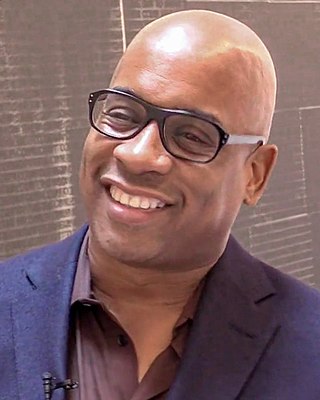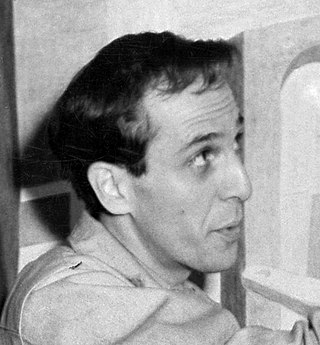
Max Carl Friedrich Beckmann was a German painter, draftsman, printmaker, sculptor, and writer. Although he is classified as an Expressionist artist, he rejected both the term and the movement. In the 1920s, he was associated with the New Objectivity, an outgrowth of Expressionism that opposed its introverted emotionalism. Even when dealing with light subject matter like circus performers, Beckmann often had an undercurrent of moodiness or unease in his works. By the 1930s, his work became more explicit in its horrifying imagery and distorted forms with combination of brutal realism and social criticism, coinciding with the rise of nazism in Germany.

Morris Louis Bernstein, known professionally as Morris Louis, was an American painter. During the 1950s he became one of the earliest exponents of Color Field painting. While living in Washington, D.C., Louis, along with Kenneth Noland and other Washington painters, formed an art movement that is known today as the Washington Color School.

Glenn Ligon is an American conceptual artist whose work explores race, language, desire, sexuality, and identity. Based in New York City, Ligon's work often draws on 20th century literature and speech of 20th century cultural figures such as James Baldwin, Zora Neale Hurston, Gertrude Stein, Jean Genet, and Richard Pryor. He is noted as one of the originators of the term Post-Blackness.

Philip Guston, was a Canadian American painter, printmaker, muralist and draftsman. Early in his five decade career, muralist David Siquieros described him as one of "the most promising painters in either the US or Mexico," in reference to his antifascist fresco The Struggle Against Terror, which "includes the hooded figures that became a lifelong symbol of bigotry for the artist." "Guston worked in a number of artistic modes, from Renaissance-inspired figuration to formally accomplished abstraction," and is now regarded one of the "most important, powerful, and influential American painters of the last 100 years." He also frequently depicted racism, antisemitism, fascism and American identity, as well as, especially in his later most cartoonish and mocking work, the banality of evil. In 2013, Guston's painting To Fellini set an auction record at Christie's when it sold for $25.8 million.
Raoul De Keyser was a Belgian painter who lived and worked in Deinze, Belgium.
Ena Swansea is an artist based in New York City. Her paintings often take memory as a point of departure.
Archie Rand is an American artist from Brooklyn, New York, United States.

Ruth Root is an American artist based in New York.

Jonathan Lasker is an American abstract painter based in New York City whose work has played an integral role in the development of Postmodern Painting. He is represented by Greene Naftali Gallery, New York.
Cora Cohen was an American artist whose works include paintings, drawings, photographs, and altered x rays. Cohen is most known for her abstract paintings and is often identified as continuing the tradition of American Abstraction. In a 2023 review in Artforum Barry Schwabsky suggested that "Cohen’s determination to evade stylistic consistency has made her one of the most underrated painters in New York." The New York Times' critic Michael Brenson wrote of her 1984 exhibition, Portraits of Women: "The works are dense, brooding and yet elated. The turbulence of the paint not only looks but also feels like freedom." Cohen interviewed many other artists also associated with continuing the tradition of American Abstraction for Bomb Magazine including; Ralph Humphrey, Dona Nelson, Craig Fisher, Carl Ostendarp, and Joan Mitchell. Her work has also been identified with traditions of European abstraction, and specifically German abstraction, including the work of Wols, Sigmar Polke, Gerhard Richter. She began exhibiting in Germany in the early nineties and continued to show at some of its most prestigious institutions.
Russ Warren is an American figurative painter who has exhibited extensively throughout the U.S. and abroad, notably in the 1981 Whitney Biennial and the 1984 Venice Biennale. A painter in the neo-expressionist style, he has drawn inspiration from Spanish masters such as Velázquez, Goya and Picasso, as well as from Mexican folk art and the American southwest. Committed to his own Regionalist style during his formative years in Texas and New Mexico, he was picked up by Phyllis Kind in 1981. During those years he transitioned to a style characterized by "magical realism", and his work came to rely on symbol allegory, and unusual shifts in scale. Throughout his career, his paintings and prints have featured flat figures, jagged shadows, and semi-autobiographical content. His oil paintings layer paint, often incorporate collage, and usually contain either figures or horses juxtaposed in strange tableaux.

Olivier Mosset is a Swiss visual artist. He lives and works in Tucson, Arizona.

The MACM, the Mougins Museum of Classical Art is an art museum located in the village of Mougins, in the Alpes-Maritimes department, France. It is 30 minutes from Nice airport and 15 minutes from the centre of Cannes.
Katherine Bowling is a painter known for her layered landscape paintings that draw inspiration from nature in the Hudson Valley.
Amy Feldman is an American abstract painter from Brooklyn, New York.

Porfirio DiDonna (1942–1986) was a 20th century American artist based in New York City.
Hayley Barker is an American painter. Exhibition A has described Barker's painting practice as the following: "Barker's main subject is the natural world, which she renders expressively in oil on linen. The intuitive undercurrent in her approach enlivens the real and imagined scenes she paints, allowing viewers to pierce directly through to the space between things."
Monica Tap is a Canadian painter, artist and educator. She lives in Toronto, Ontario, and teaches at the University of Guelph. She is known for engaging and challenging conventions concerning landscape and still-life painting.

City Limits is a 1969 painting by Phillip Guston, part of his “hoods” series of representational works. These paintings depicted cartoonish versions of Klansmen engaged in various mundane activities. While other works in this series featured the artist himself under the guise of a KKK member, City Limits provides a more straightforward depiction. The child-like presentation has been described as enabling “a simple account of the simple-mindedness of violence.” It is influenced by his early work with Mexican Muralists and was part of his polarizing abandonment of Abstract Expressionism as a genre at his 1970 Marlborough Gallery exhibition. It is featured in Philip Guston Now, a traveling retrospective that generated controversy when it was postponed in 2020.
Betsy Kaufman is a visual artist based in New York known for abstract paintings and works on paper, as well as needlepoint sculptures. Critics distinguish her work by its subversion of modernist systems and its insertion of strong emotion, humor, and narrative into geometric abstraction. Writer Ingrid Schaffner observed that Kaufman's paintings are "inherently based on disruption … She has made the accidents, oppositions, contradictions, and mercurialness, which most organizing impulses work hard to minimize, into the rationale that guides the unpredictable and forceful narrative of her abstractions." Kaufman has exhibited at the Brooklyn Museum, Musée d’art moderne de Saint-Etienne (France), Queens Museum of Art, Staatsgalerie Stuttgart (Germany) and the Tang Museum, among other venues.












